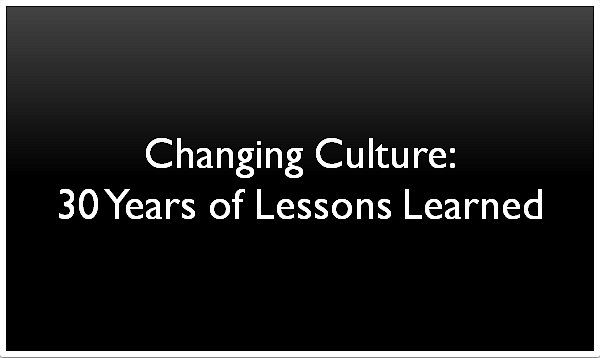
Where to Next for the CEO & Culture?
Where to Next for the CEO & Culture?
1) Identify the behaviors that underpin agility, innovation, and high performance
Make sure that these behaviors are consistently demonstrated by everyone – no exceptions, no excuses. Bizzarri talks about attracting the right people. This is futile if those people enter an environment where the company values and culture are only demonstrated by some. He clearly calls upon everyone, from his newest hire to his senior C Suite executives, to demonstrate the key behaviors Gucci wants as part of its future.
Bizzarri speaks to what some of these valued behaviors are: respect, collaboration, transparency, creativity, and risk-taking. These are the foundation for company-wide agility, innovation, and high performance.
Every CEO in 2018 needs to be explicit about the specific behaviors needed across the organization. This includes foundational behaviors that strengthen productivity and manage risk (respect, collaboration, agility) and strategic behaviors that ensure a successful future (innovation, customer experience).
2) Lead by Example
Too often top leaders define a desired culture, talk about it, even hire for it, but then allow top performers to violate that culture. This is a difficult struggle that requires courage, especially when quarterly results hinge on this performer’s output.
A top performer may drive brand vibe or customer and investor confidence. Allowing violations of values erodes the underlying robustness and agility of the organization. More to the point, it creates significant risks to reputation and viability. Take one look at the numerous Entertainment and Media scandals of the past several months for abundant proof.
As Bizzarri says, “You need to show that you believe in that and that you [remove] all the people who do not follow this kind of respect you want to create in the company.”
3) Make it an Ongoing Activity
Bizzarri states, “You need to show on a daily basis that you really believe in these values.” This requires tireless vigilance, especially at the level of senior leaders. These are the individuals who set the standard for what is acceptable behavior. Messages about culture ripple throughout the organization daily. CEOs need to make sure they are the right ones.
We were part of a meeting at a Retail organization recently. In this meeting, a Division President and his GMs paused for a short time to allow Marketing to demonstrate a potential design for new uniforms. Two male employees demonstrated male uniforms and jackets. As the female Marketing Director took off the new windbreaker to reveal the female uniform, a sound was heard across the room.
This sound seemed to suggest that this woman looked good in the uniform more than the uniform was a good selection. The senior leader asked for a break and immediately pulled his team into a side room. He asked each person what had happened in the room and what each of them thought he or she needed to do about. Accountability was individual and collective. Every leader returned and apologized to the Marketing Director.
More importantly than making the situation right, this was treated as another learning experience for the various leaders. They were able to collectively reflect on how their behaviors were received by others, and how they could better create a safe and inclusive environment.
4) Shift Organization Practices
Bizzarri describes how he has intervened to shift some of Gucci’s practices to adapt to the external customer change of a more Millennial market. This is a perfect example of adaptation to a complex, dynamic marketplace where traditional ways of managing a business no longer work. In 2018, every CEO needs to be searching out practices that aren’t aligned to the desired culture. They need to switch or realign these practices in order to deliver strategic goals and growth.
Gucci’s substantial turnaround may be due to its CEOs willingness to break with traditional routines and search for new ones. The examples of changes Bizzarri talks about are instructive:
- A Shadow Comex – a shadow team of younger employees providing input to the executive committee
- Resourcing of talent and ideas from external talent sources around the world, rather than persisting in traditional practices
- Use of an off-site meeting to pull influential people together to understand how to work together in new ways
- Decision making based on expert knowledge versus hierarchical position
Each of these builds on current culture strengths while creating new and adaptive approaches to working together.
Every organization operates using four kinds of practices:
- Managing – planning, financial management, resource management, risk management, etc.
- Operating – what the organization does to deliver products and services
- Social – the way people work together
- Organizational Learning – how the organization improves and adapts
New CEOs often have the vision to spot where changing a few practices can shape the culture. A perfect example of this was when Alan Mullaly took over at Ford. Sometimes, CEOs who have had a long, successful career need help.
One such CEO brought 180 global leaders together to focus on cross-boundary collaboration as a strategic culture priority. The CEO then explored with them what needed to be different. It became painfully apparent that what had brought them success in the past was not working anymore. Deep insights set the stage for redesigning several Managing Practices.
5) Measure Your Progress
One of the most difficult challenges for CEOs is understanding the reality of the current culture. This includes how the company operates and where they should pay attention.
Organizations are complex, with culture strengths that can contribute to strategy or undermine it. They have culture weaknesses that may create vulnerability and risk. Subcultures within departments, divisions, professions, and generations all need to be understood so leaders know what needs attention.
In 2018, CEOs need to be asking how culture will be measured in their company. They need to:
- Look broadly at culture to understand its foundation and how strong and resilient it is for change
- Understand the unique culture DNA that needs to be valued and leveraged
- Track where and how strategy is being supported by changes to culture.
This means more than measuring Engagement, Compliance, or Quality. All are important. They’re the parts of the elephant if we think of the old metaphor, but not a cohesive picture of culture and its impact on future success.
In 2018, CEOs need to wrestle with their culture measurement system and make sure it is feeding important data for action up, down, and across the organization.
Gucci is experiencing its strongest period of financial growth in 20 years with 20 consecutive quarters of revenue growth in a slowing market. This means it’s achieving not just organic growth, but also taking market share from its competitors. Bizzarri has made clear choices and responded with creativity, persistence, and courage to shape the business and its culture for competitive success.
In 2018, CEOs still need to worry about strategy and transformation, about risk and reputation, about brand and engagement, but they need to step up their focus on culture on a broader and deeper level if they want to protect the organization and survive an increasingly complex and dynamic world.









